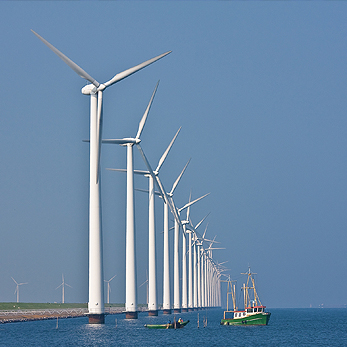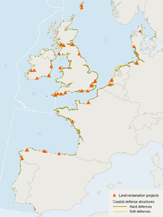Various artificial structures have been constructed within the OSPAR area. Land has been reclaimed to extend ports and provide associated industrial zones and various sites have been proposed for future land reclamation projects. Coastal defence structures have been installed to prevent erosion and protect against flooding at vulnerable sites. Many ports, marinas, piers and other infrastructure have been created. It is estimated that over 13 000 individual structures have been placed in the OSPAR area Figure 9.9.
Construction activities can have a range of impacts on the marine environment. They may cause loss or damage of coastal habitats and changes to the physical nature of the seabed, which in turn cause erosion, sedimentation and physical and chemical disturbance of ecosystems. While the structures are under development there may be more underwater noise, water pollution (e.g. higher turbidity), and air pollution. Foraging or breeding seabirds and marine mammals are affected by visual or noise disturbance. There may be a loss of space for human activities, such as coastal fishing.
Since 1998, OSPAR countries have reported on the reclamation of around 145 hectares from the sea and coastal wetlands, mainly in the form of small-scale developments. Most sites, including the largest, are located in Region II. Typical habitats affected by land reclamation and the construction of other structures include sandbanks, estuaries, mudflats and salt marshes. Long-term growth in world trade is likely to lead to more development of shipping-related infrastructure.
Extensive lengths of coastline in the OSPAR area are protected against erosion by coastal defence structures. Techniques employed include dykes, groyne fields, seawalls, and beach nourishment schemes to replace sand lost from beaches. The almost unbroken line of coastal defence schemes protecting the southern coast of the North Sea and parts of its west coast has caused extensive fragmentation of habitats. Hard-engineered coastal defence structures, such as seawalls and dykes, change ecosystems and create new hard-bottom habitats. Soft-engineering coastal structures, such as dunes and salt marshes, are increasingly being employed to act as natural buffers against rising tides. These work with the coastal sediment balance to ensure coastal stability. Beach nourishment means more marine sand and gravel extraction. The projected rise in sea levels, storm frequencies and wave loads is likely to increase the need for coastal protection measures, especially in the southern North Sea.
OSPAR countries regulate land reclamation, coastal defence works and the construction of other structures through national legislation. The aim is to minimise and put right any adverse environmental effects. National regulations for coastal defence often prioritise natural and soft techniques. This is supported by EU legislation, such as the Environmental Impact Assessment Directive, the Habitats Directive, the Birds Directive and the Recommendation on Integrated Coastal Zone Management.
EIAs for land reclamation, coastal defence works and other structures have identified various effects on marine ecosystems. Although the regulatory system appears adequate for controlling impacts on a site by site basis, in most cases monitoring data are not available to evaluate the actual changes in environmental quality. For the recently started expansion of the port of Rotterdam in the Netherlands (Maasvlakte 2 project) an extensive monitoring programme will be carried out to investigate the recovery of benthic fauna, concentrations and spread of suspended matter, physical effects and underwater noise. In developments where negative effects are expected or observed, compensation is often more feasible than remediation.
To help address gaps in knowledge of cumulative and wide-scale effects, a coordinated system is required for collecting and reporting information on land reclamation, coastal defence structures and other artificial structures. This will help improve the effectiveness of regulations and other measures for managing impacts.
OSPAR countries should promote a shift to a sediment management approach and modern methods of soft coastal engineering, which reinforce natural coastal defences (such as salt marshes and dunes) and protect key sources of sediment. OSPAR guidelines should be updated to include best options and practices for use of marine sand and gravel for coastal defence. The updates should reflect the experience of OSPAR countries, strategies under the EU Water Framework Directive and the need to adapt to rising sea levels and increased flood risk.


